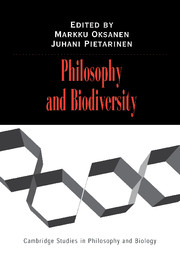Book contents
- Frontmatter
- Contents
- List of Figures and Tables
- List of Contributors
- Acknowledgements
- Philosophy and Biodiversity
- Part I USING ‘BIODIVERSITY’
- Part II UNDERSTANDING BIODIVERSITY
- Part III VALUING BIODIVERSITY
- 6 Jean-Jacques Rousseau
- 7 There Is Biodiversity and Biodiversity
- 8 Evaluating Biodiversity for Conservation
- 9 Limits to Substitutability in Nature Conservation
- Part IV PROTECTING BIODIVERSITY
- Index
- References
8 - Evaluating Biodiversity for Conservation
A Victim of the Traditional Paradigm
Published online by Cambridge University Press: 26 June 2009
- Frontmatter
- Contents
- List of Figures and Tables
- List of Contributors
- Acknowledgements
- Philosophy and Biodiversity
- Part I USING ‘BIODIVERSITY’
- Part II UNDERSTANDING BIODIVERSITY
- Part III VALUING BIODIVERSITY
- 6 Jean-Jacques Rousseau
- 7 There Is Biodiversity and Biodiversity
- 8 Evaluating Biodiversity for Conservation
- 9 Limits to Substitutability in Nature Conservation
- Part IV PROTECTING BIODIVERSITY
- Index
- References
Summary
NATURE CONSERVATION AND THE HISTORICAL LEGACY
The conservation strategy for nature reserves in modified landscapes in the United Kingdom is essentially based on the “historical principle” (Peterken 1996) which maintains the argument that wildlife will be best served by continuing the historic form of land use practice in those ancient seminatural habitats that have a past record of management.
The countryside across much of Europe has been shaped by centuries of intensive management that has given rise to a cultural landscape (Fry 1991) characterized by features which may include coppice woodlands, heathlands, grazed flood meadows, and organized reed beds. According to Morris, in the United Kingdom many of these areas represent the cherished landscape and are designated as nature reserves, parks, or other forms of protected land. An important element in landscape and wildlife conservation has been the appeal to historical precedent. Consequently, to the modern conservationist, species of young sere-stage communities come to represent the norm. Furthermore, past management practices, which have shaped this natural heritage, are now enjoying a renaissance as the modern solution to conserving biodiversity by maintaining the status quo. The biological interest of many of the reserve sites shows that its past management has been successful, up to a point (Morris 1991). However, we know almost nothing of what has been lost from biologically rich sites as our basis for comparison is contemporary.
- Type
- Chapter
- Information
- Philosophy and Biodiversity , pp. 172 - 179Publisher: Cambridge University PressPrint publication year: 2004



